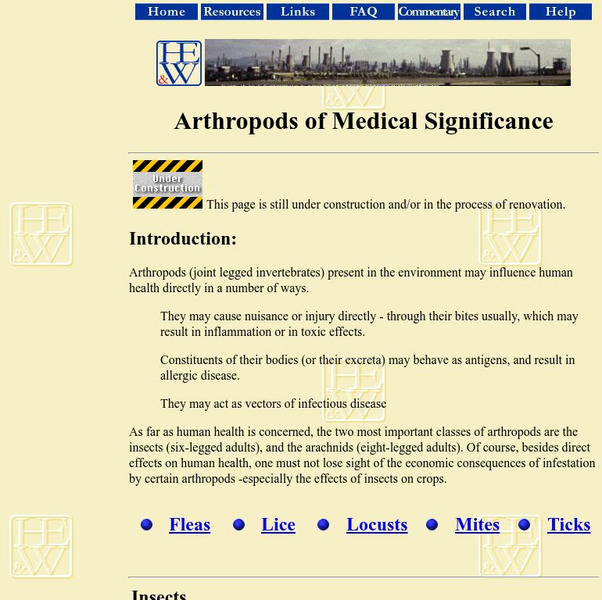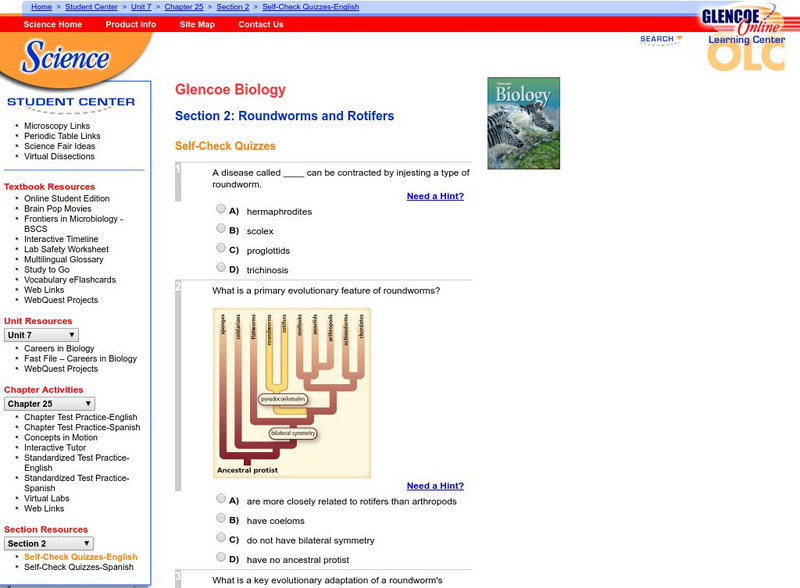Scholastic
Study Jams: Symbiosis
Three types of symbiosis are explained: parasitism, commensalism, and mutualism. This is done with colorful animation and lively dialogue in a straightforward and easy-to-follow manner. Have your ecology class watch this at home and then...
Smarter Balanced
Communicable Diseases
Pathogens, what they are, how they spread, and how to prevent them from spreading are the focus of this resource that can be used to prepare learners for a performance task assessment or to begin the study of communicable diseases.
Curated OER
Swell Homes
Students investigate galls. In this gall lesson, students inspect plants and locate galls present on leaves. Students collect galls from various plants and analyze the contents.
Curated OER
Parasite Development and Life Cycle
If you are new to teaching agriculture classes, this outline may be helpful when you are preparing a lecture on parasites in livestock. In addition to lecturing on this topic, the lesson plan suggests that learners research the life...
Curated OER
Viruses and Simple Organisms
In this simple organisms worksheet, students review the characteristics of bacteria, viruses, parasites, monerans, and protists. This worksheet has seven matching, five true or false, five multiple choice, and four short answer questions.
Curated OER
Super Scientist Quiz
In this science worksheet, students match each of the descriptions on the right to the correct scientist listed on the right. There are thirty scientists to identify and match on the sheet.
Curated OER
Biology 11 Word Search
In this biology learning exercise, students locate and identify various vocabulary terms related to biology. There are twelve words located in the puzzle to find.
Curated OER
Simulating the Spread of an Infectious Disease
In this health worksheet, students identify various infectious diseases and explore the available options for stopping or preventing the spread of disease. They participate in a simulation experiment on how to measure and prevent. There...
Curated OER
Smallest Thing
Students compare characteristics of myobacteria and viruses to determine which is the smallest life form. They read and discuss an article that presents different viewpoints on the definition of life to determine their own viewpoint.
Curated OER
Classy
Students explore the classification system in this seven lessons unit. The diversity of life forms and their characteristics are examined using a microscope. Kingdoms, classes, and families are investigated.
Science Buddies
Science Buddies: Froggy Forecasting: How Frog Health Predicts Pond Health
Have you ever heard the expression "a canary in a coal mine"? In the 1900s and earlier, coal miners brought canaries with them into the mines to act as early warning signals. The canaries were very sensitive to low levels of dangerous...
Other
Agius: Arthropods of Medical Significance
An overview of how arthropods play a very important role in influencing human health; they may act as vectors of infectious disease.
University of Wisconsin
The Why Files: Mosquito Bytes
Everything you might need to know about mosquitos can be found here. The lesson plan includes a lab that investigates the effect of temperature on mosquito egg development.
Other
Implications of Sequencing Caenorhabditis Elegans Genome for Plant Nematology
From The American Phytopathological Society, this is a detailed discussion of the genomic sequencing of a type of nematode which is a plant parasite, including how knowledge of the genome structure might make it possible to create crop...
University of Nebraska
University of Nebraska State Museum: Parasite Sleuth: Where Parasites Live
This site highlights 10 parasites, including worms, insects, ticks and microorganisms. For each organism you can get information concerning their life cycle and geographic distribution.
Science Education Resource Center at Carleton College
Serc: Goldenrod Gall Investigation
In this life science field investigation students study goldenrod gall population.
Climate Literacy
Clean: Climate Change and Disease
Learners research the relationship between hosts, parasites, and vectors for common vector-borne diseases and evaluate how climate change could affect the spread of disease.
McGraw Hill
Glencoe Biology: Roundworms and Rotifers: Self Check Quiz
This multiple-choice quiz on roundworms and rotifers allows students to get hints for each question and check their answers after submitting.
Scholastic
Scholastic: Study Jams! Science: Ecosystems: Symbiosis
Symbiosis is featured in this video to help students understand the process through an engaging video. Know terms like parasites and mutualism to be successful on the test.
Biology 4 kids
Biology4 Kids: Quiz: Microorganisms
Take this ten-question review quiz over microorganisms. Read more about each question after an incorrect answer is given.
Biology 4 kids
Biology4 Kids: Flatworms
Learn about some characteristics and environments of the super-primitive flatworm species.
Cells Alive
Cells Alive!: Protozoan Parasites
Two video clips and facts of two different types of protozoan parasites are offered: Giardia lamblia and Entamoeba hystolytica. Images and information are also provided about Cryptosporidium parvum.
Famous Scientists
Famous Scientists: Benjamin Cabrera
Learn about the Filipino scientist, Benjamin Cabrera, who specialized in parasitology.
Curated OER
Kids Health: Why Lice Aren't So Nice
Use this site to find out exactly what lice are, why they like people, and most importantly, how to get rid of them.

























